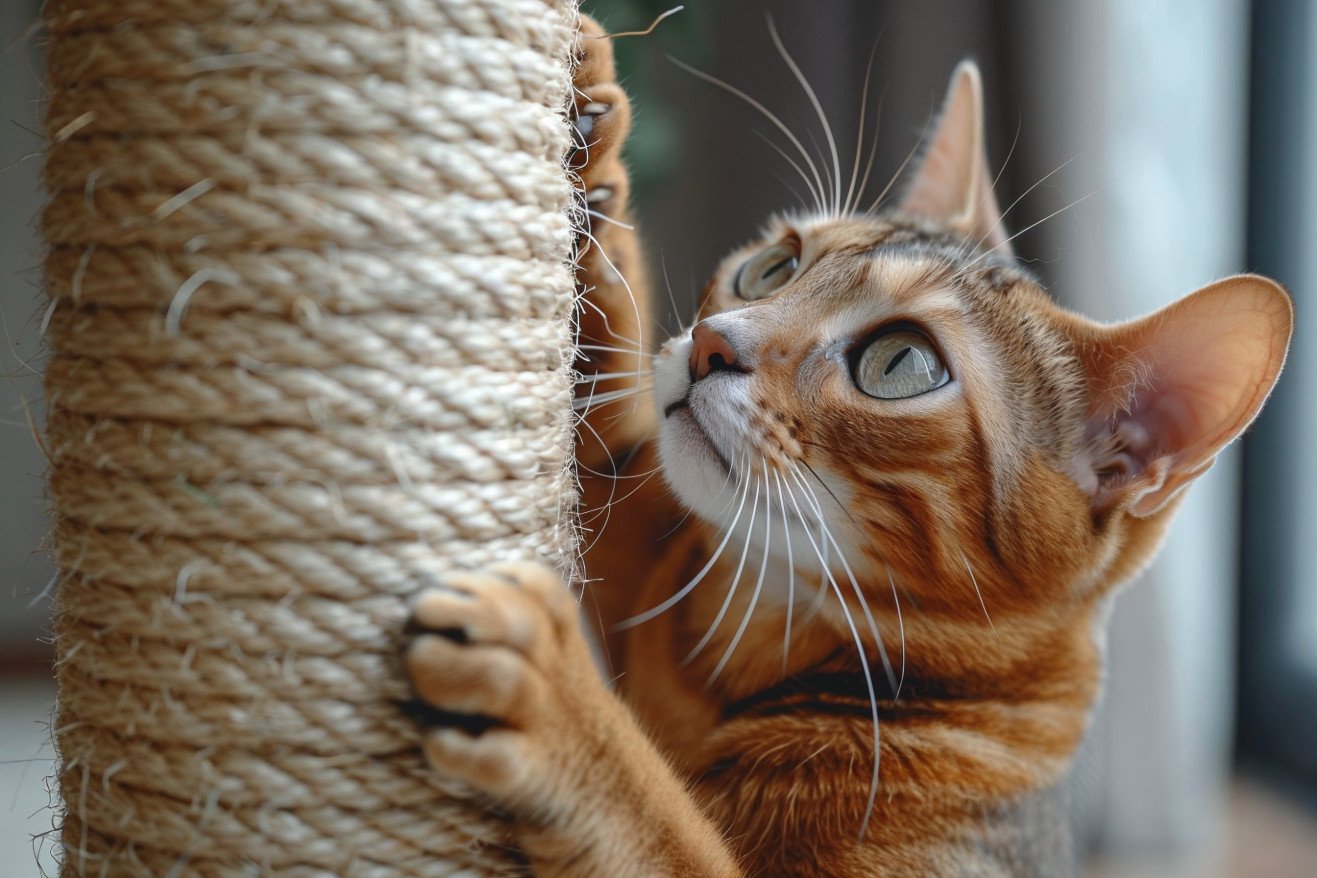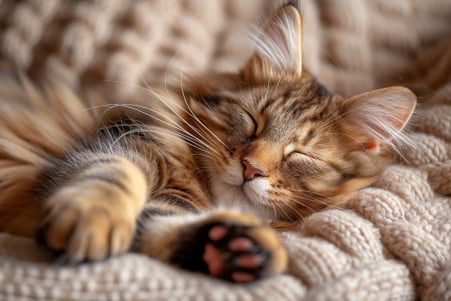Why Do Cats Shed Their Claws? A Look at This Natural Behavior
28 February 2024 • Updated 27 February 2024

If you’re a cat owner, you’ve probably found the leftover pieces of your cat’s claws around your home and wondered why and how this happens. The truth is that cats do shed the outer layer of their claws, and it’s a normal part of the claw’s life cycle.
Cats help this process along by scratching, which helps them get rid of the old layer and reveal the new, sharper claw underneath. This behavior is important for keeping their claws healthy and strong.
To fully understand why cats shed their claws, we need to look at a combination of information from veterinarians, biologists, and cat behaviorists. Knowing the anatomy, health, and behavior behind this process is important for cat owners.
We’ll also share some advice on how to make sure your cat’s claws are well-cared for. Let’s take a deep dive into the world of your cat’s claws and how you can make sure you’re supporting their natural instincts.
Why do cats shed their claws?
Anatomy and Life Cycle of Cat Claws
The anatomy of a cat’s claw is a marvel of evolutionary engineering, with a tough, protective keratin sheath surrounding a sensitive core called the quick, which contains nerves and blood vessels.
According to Cat Bandit Blog, the keratin sheath is periodically shed, which is necessary to keep the claw sharp and functional. The life cycle of a cat’s claw is about four to six weeks long and includes periods of growth, rest, shedding, and replacement, with the shedding happening in the middle of the cycle.
As new layers of keratin form, the old layers become the sheaths that will eventually be shed, and this process is essential to the health and sharpness of the claw. There are several factors that can affect the frequency and success of the shedding process, including the cat’s age, activity level, and health. For example, younger cats shed their sheaths more often than older cats.
To avoid problems like overgrown or ingrown claws, which can be painful or lead to infection, it’s important for cat owners to regularly trim and check their cat’s claws. By learning about the anatomy and life cycle of cat claws, cat owners can make sure their furry friends’ paws are healthy and ready for their next adventure, whether it’s a climb or a playful pounce.
The Complex Biology of Cat Claw Maintenance
While cats scratch to mark their territory and stretch their muscles, they also scratch to maintain the health of their claws. In fact, the cornified claw sheath is a highly specialized structure that has evolved to enable the natural shedding of the claw’s outer layer.
A study of the cornified claw sheath found that it contains microcracks that are essential for the shedding of the apical horn caps. This enables cats to maintain sharp claws that are essential for climbing and hunting.
The act of climbing and other physical activities place tensile forces on the cat’s claws, which activates the natural shedding process.
The forces that are placed on the claws as the cat moves through its environment cause the outer layer to be shed and flake off, which allows the new, sharper claws to grow underneath the sheath.
This process has been honed by the cat’s active lifestyle and predatory history. The shedding of the claw sheath in cats is more complex than in other animals and is a result of their evolution as precision-based hunters. The study shows that the natural behaviors of cats are critical to the health of their claws and raises questions about the consequences and potential health issues of not maintaining the natural shedding process.
The study shows that the natural behaviors of cats are critical to the health of their claws and raises questions about the consequences and potential health issues of not maintaining the natural shedding process.
Protecting Your Cat’s Claws: Common Problems and How to Help
Keeping your cat’s claws in good shape is important for more than just looks—it’s also important for your cat’s health and comfort. According to Dr. Joanna Woodnutt, cats can experience pain and discomfort from issues like overgrown claws, ingrown claws, and infections.
That’s why it’s important to regularly check your cat’s claws for any of these issues. Dr. Luqman Javed also notes that proper trimming can prevent overgrowth and make sure the claws don’t grow into the paw pads.
If you’re looking for an alternative to declawing, which is becoming increasingly controversial, Dr. Brenda Stevens recommends nail caps and making sure your cat has a variety of scratching posts and surfaces to choose from. She also suggests using different substrates like wood, rope, or cardboard to meet your cat’s individual scratching needs, which can help them maintain their claw health.
If you don’t stay on top of your cat’s claw care, it can lead to serious issues like infections and even behavioral problems. By learning about the importance of claw shedding and making sure you’re taking the right steps to care for your cat’s claws, you can help your cat avoid the pain and mobility issues that come with claw-related health problems.
Plus, it can help you better understand the importance of scratching behavior in general, which is essential for maintaining claw health and your cat’s overall well-being.
Why Do Cats Scratch? It’s Not Just for Claw Health
While claw health is one reason for scratching, there’s more to it than that. Cats scratch for a number of reasons: it’s a natural way for them to mark their territory, both visually and with scent from glands in their paws. The Oregon Veterinary Medical Association also points out that scratching helps cats stretch and tone their muscles, providing them with a full-body workout.
Scratching also plays a big role in claw health, helping cats shed old claw sheaths and grow new, sharp claws. The impact of scratching on cats and their owners is clear. A study in PMC even found that the use of a variety of scratching posts, including sisal rope and cardboard, can help meet cats’ scratching needs and reduce the damage to furniture.
The Oregon Veterinary Medical Association recommends redirecting a cat’s scratching to appropriate areas with positive reinforcement, such as treats or catnip, and placing scratching posts near their favorite places to scratch. By understanding and working with these natural behaviors, cat owners can help ensure their pets’ well-being and claw health and protect their furniture.
The Importance of Cat Claw Health: A Review
In wrapping up our discussion of cat claw shedding, it’s clear that this process is more than just an interesting quirk of cat behavior. According to Wagz ‘n Whiskerz Pet Sitting, the shedding of the outer claw sheath is an important way for cats to maintain the sharpness of their claws, which is important for hunting and self-defense.
Cat owners need to make sure that they check their cats’ claws regularly and trim them when necessary to avoid overgrowth and the problems that can come with it, so that their cats’ feet are always in fighting shape.
It’s important to note that proper claw care is important to avoid painful issues like ingrown claws. Cat owners should make sure that they provide their cats with scratching posts and other surfaces that will help them keep their claws in good shape and allow them to express their natural behaviors.
It’s also true that while claw-shedding is normal, cat owners should make sure to take their cats to the vet if they notice any changes in their cats’ claw-shedding patterns or if their cats’ claws seem to be breaking more easily.
In caring for our cats, it’s important to remember that supporting their natural behaviors, like scratching, is important to their overall health and well-being. As cat owners, it’s our job to help our cats express their natural behaviors in healthy ways and to support them with the knowledge and care that will help them live their best lives.


